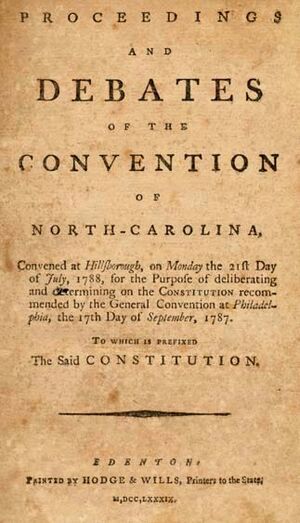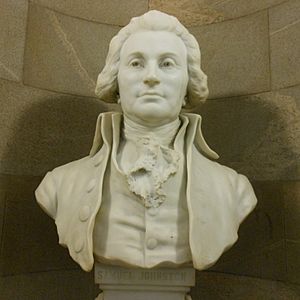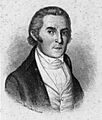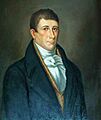Hillsborough Convention facts for kids
The Hillsborough Convention was a very important meeting in North Carolina's history. It was the first of two meetings where leaders in North Carolina discussed whether to approve the new United States Constitution. This Constitution was a plan for how the new country would be governed.
Delegates, who were like representatives, came from 7 towns and 59 counties. This even included six western counties that later became part of the state of Tennessee. They met in Hillsborough, North Carolina from July 21 to August 4, 1788. Their main goal was to decide if North Carolina would agree to the Constitution. This new plan had been suggested by a big meeting in Philadelphia the summer before.
The delegates were chosen in special elections held in March 1788. Governor Samuel Johnston was in charge of the Convention. Most of the people at the Hillsborough Convention were "Anti-Federalists." These were people who didn't want a strong central government. Because of this, North Carolina didn't approve the Constitution at this meeting. They waited until another meeting, called the Fayetteville Convention, which happened a year later.
Contents
Where Did They Meet?
The convention took place in Hillsborough, North Carolina. They met at the St. Matthew's Episcopal Church, which was a Church of England building. This church was on lot 98 in Hillsborough.
This church was a popular meeting spot. It was also where the third Provincial Congress of North Carolina met in 1775. The North Carolina Legislature also met there in 1778, 1782, and 1783. Sadly, the church building was destroyed by fire before the 1800s. A new building was built on the same spot in 1814. It later became the Hillsborough Presbyterian Church in 1816.
Two Sides: Federalists and Anti-Federalists
At the convention, there were two main groups with different ideas.
The Federalists wanted a stronger national government. Key Federalist leaders included James Iredell Sr., William Richardson Davie, and William Blount. They believed that the country might fall apart if the national government wasn't powerful enough. They felt that the old plan for the country, called the Articles of Confederation, didn't give the government enough power.
On the other side were the Anti-Federalists. Their leaders included Willie Jones, Samuel Spencer, and Timothy Bloodworth. The Anti-Federalists were worried about a strong national government. They feared it might take away the power of the states and the rights of individual people. There were twice as many Anti-Federalists as Federalists at the meeting.
Even though the Federalists knew they would probably lose the vote, they brought someone to write down everything that was said. They hoped that by publishing their arguments, they could change public opinion later.
What Was the Result?
After much discussion, the delegates voted 184 to 84. They decided not to approve or reject the Constitution right away.
One big reason North Carolina didn't approve the Constitution was that it didn't have a Bill of Rights. A Bill of Rights lists the important freedoms and rights of citizens. The delegates at Hillsborough suggested many changes to protect personal freedoms. They strongly asked the new national Congress to add a Bill of Rights to the Constitution.
North Carolina did not officially become part of the United States until it approved the Constitution. This happened more than a year later, in November 1789, at the Fayetteville Convention.
Delegates Who Attended
There were 294 known delegates from the 59 counties and seven towns of North Carolina. Some of these counties, like Greene, Sullivan, Sumner, Tennessee, and Washington, later became part of the state of Tennessee in 1796. The election of delegates from Dobbs County was canceled because of fighting that caused the ballot box to be lost.
Governor Samuel Johnston was the leader of the Convention. Even though he lived in Chowan County, he represented Perquimans County at the meeting. John Hunt was the secretary, and James Taylor was his assistant. The doorkeepers were William Murfree, Peter Gooding, Nicholas Murfree, and James Mulloy.
Images for kids














